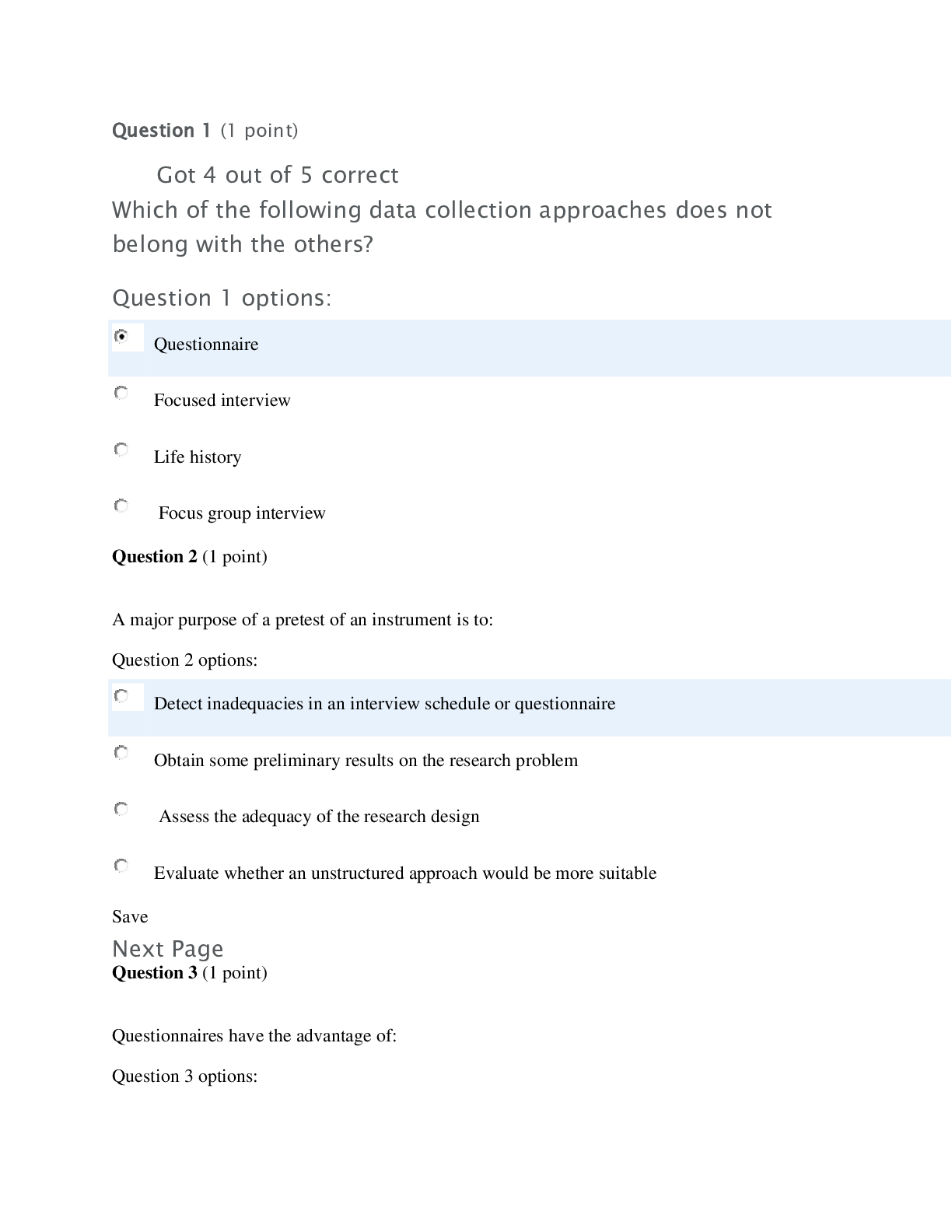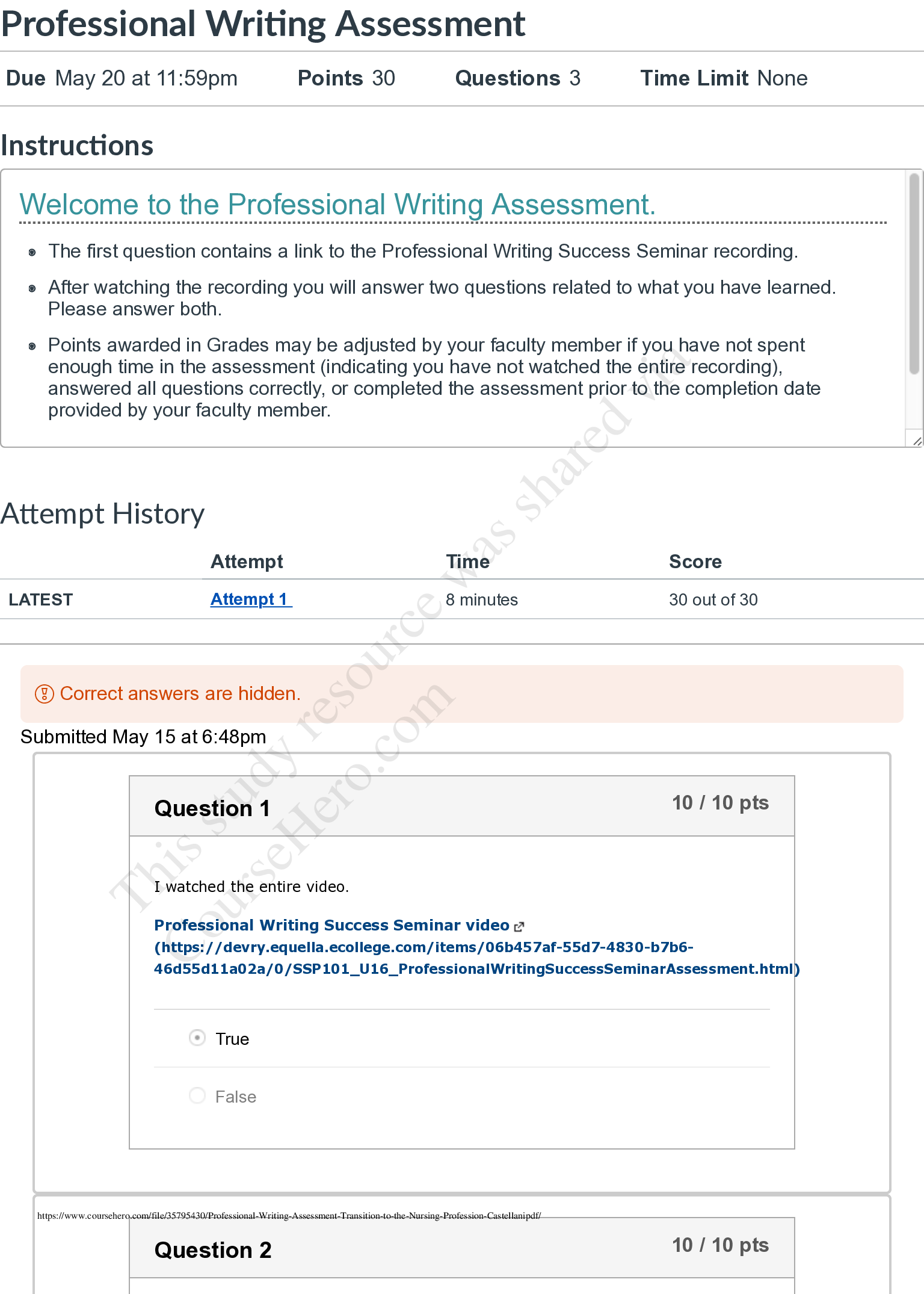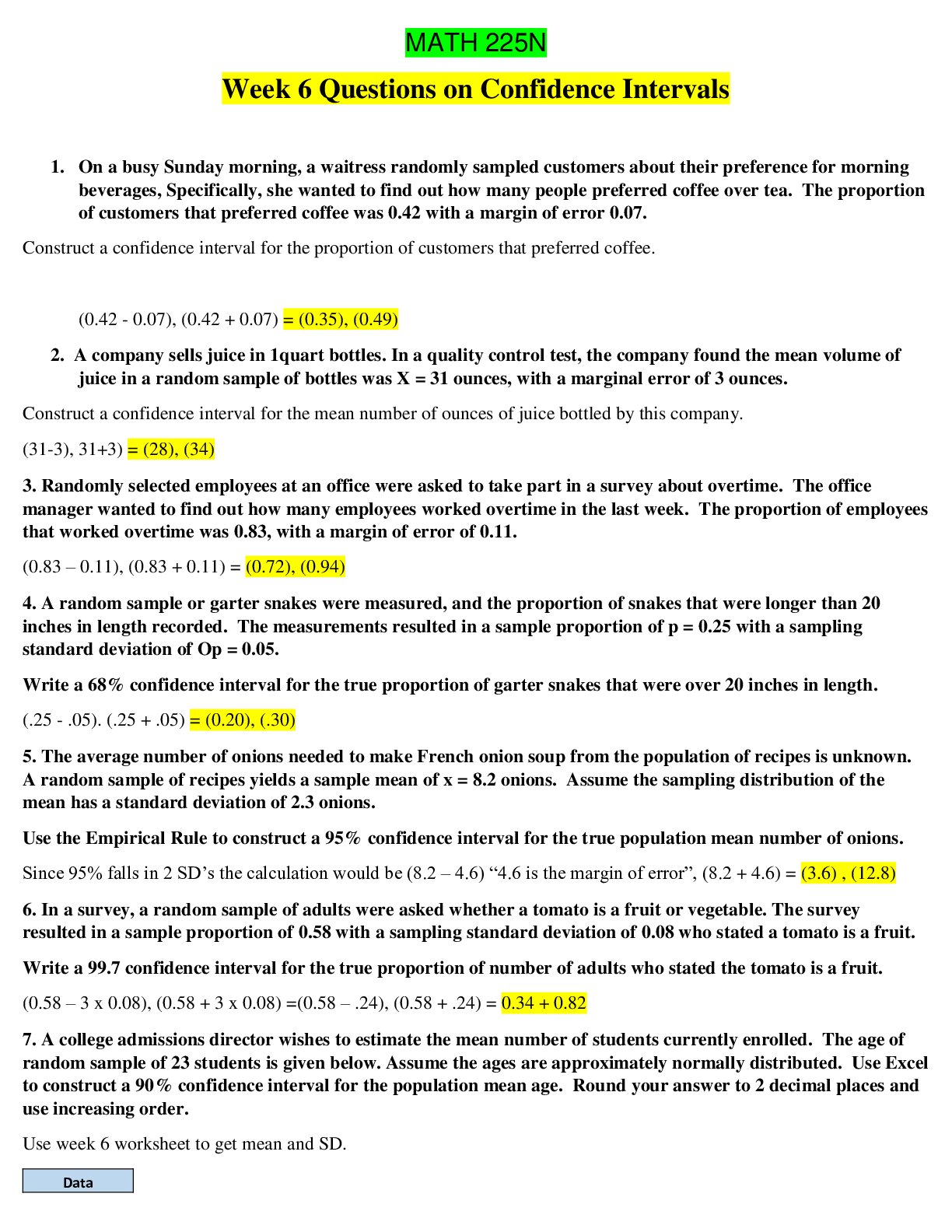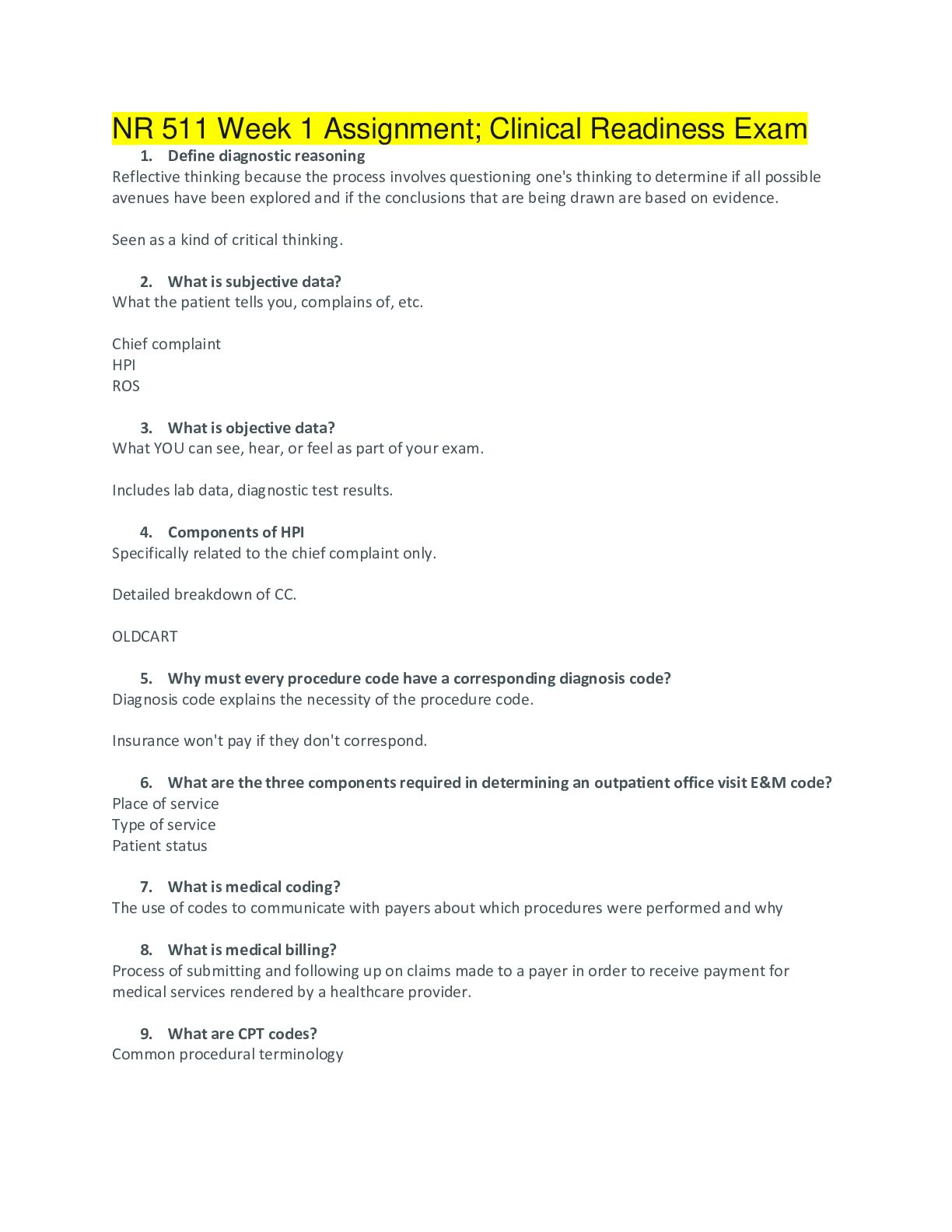NURS 3325 MODULE QUIZ 1 Questions And Answers (UPDATED)
Document Content and Description Below
A gerontologic nurse is aware of the demographic changes that affect the provision of health care. Which of the following phenomena is currently undergoing the most rapid and profound change? More... families are having to care for their aging members Adult children find themselves participating in chronic disease management A growing number of people live to be very old Elderly people are having more accidents, increasing the cost of health Question 2 A nurse is helping is helping to plan the long-range goals of a public health organization. When planning to accommodate changes in demographics, what phenomenon should the nurse address? Life expectancy has declined slightly since 1990's Demographic changes are similar across cultures and ethnic groups Average life expectancy is higher than it has ever been Older adults are decreasing as a proportion of the population Question 3 A gerontologic nurse has been working hard to change negative perceptions of the elderly. What negative perceptions have been identified in the literature? A. Being the cause of social problems B. Not contributing to society C. Draining economic resources D. Competing with children for resources E. Dominating healthcare research B, C, D A, B, C B, C, E C, D, E Question 4 A nurse who works on the subacute medical unit of a hospital has noticed that the population of older adults being admitted to the unit has been increasing over the past few years. The nurse engages a colleague in a discussion about this finding. Which statement by the colleague would be reflective of current thinking about older adults? "Fortunately, Social Security ensures sufficient level of income for people over 65." "It helps that older people don't have to incur any cost for their medical care." "Most of the older clients on the unit will have come to us from a nursing home." "It's reassuring older clients are receiving more concern than in decades past." Question 5 The board of a large chain of hospitals has commissioned a strategic plan to meet the care needs of baby boomers in coming years. When developing a plan for the future, which characteristics would be most important to incorporate into the plan? a. Baby boomers typically have fewer children to help with care later than those from earlier generations. b. Adjusting for inflation, baby boomers have lower incomes than their parents had. c. Due to technology, baby boomers have more leisure time than other adults. d. Baby boomers perform physical exercise more frequently than other adults. e. The educational level of baby boomers is usually lower than preceding generations. a, d a, b, e c, d, e c, d Question 6 A nurse is providing care to a group of older adults who attend activities at the local senior center. When interacting with the group, the nurse notes that more of the women than men live alone. Which phenomena would the nurse most likely attribute to this situation? Women tend to live longer than men and marry men older than themselves. Men tend to have greater access to care facilities due to higher income and savings. Men are more likely to live with younger family members following the death of a spouse. Social pressures tend to stigmatize older men who live alone. Question 7 A nursing care aide employed on a medical unit of a hospital expresses frustration that "old people get sick so much more often than young people." Which response by the nurse would be most appropriate? "Truthfully, the prevalence of obesity and accompanying chronic illness means that young people actually have more chronic conditions than older adults." "It's actually a myth that the older adults require more hospitalizations than young people." “Actually, older adults experience fewer acute illnesses than younger people, it's just that they tend to take longer to recover from them." "With the increase in life expectancies in recent years, most older people actually live free of chronic disease until very late in life." Question 8 Persons reaching age 65 have an average life expectancy of an additional 19.5 years (20.6 years for females and 18.1 years for males). True False Question 9 Baby boomers are those born between which years? 1940-1966 1938-1960 1942-1970 1946-1964 Question 10 A gerontological nurse is working with a group of nurses in the community that serves a large older adult population. When developing appropriate plans of care, which factor would be most important for the group to address? The high prevalence of mental impairment among this population The diversity of the older adult population The fact that most older people live below the poverty line The lack of family support that is the norm among older adults Question 11 "Life Review" was first written about by? Erick Erickson Robert Butler Sigmund Freud Carl Jung Question 12 A nurse is conducting a presentation to a group of individuals at a local community center. The group consist of individual who began entering their senior years in 2011 through the present as well as those continuing to enter their senior years until 2030. Which characteristic associated with this group would the nurse need to keep in mind? They would experience fewer chronic diseases but more acute diseases They would receive greater support from their children and spouses They would be better educated and have greater wealth They would have fewer needs for hospital or nursing home care A public health nurse who directs a homecare program that serves an area with a large population of older adults is conducting a long-term strategic plan. Which phenomenon would be the most important for the nurse to integrate when planning for the future? While life expectancy will continue to rise, the percentage of older adults in the United States relative to overall population will decrease. By 2030, it is expected that the number of older adults over 85 will triple. Both life expectancy and percentage of people over 65 in the population will increase in coming decades. Chronic conditions are expected to gradually cause a decrease in the number of older adults in 10 years. Question 14 Which population is expected to be the fastest growing number of older adults. Hispanic Black Asian Non-Hispananic White Question 15 The majority of older adults will end up living: In a private home In a nursing home In an assisted living facility In a senior citizen's community Question 16 The older population in 2030 is projected to be twice as large as their counterparts in 2000, growing from 35 million to 74 million and representing nearly 21 percent of the total U.S. population. True False Question 17 A female patient is newly admitted to a long-term care facility. The patient is not satisfied with the conditions of the facility, takes a highly active role in her health care, and because of her ability to access information, has as much knowledge as her health care providers on some issues. The nurse interprets these findings as indicating the patient is most likely: A young-old female baby boomer who just turned 65 years of age. An older woman between 75 to 85 years of age An old woman over age 85 An elite older woman older than 100 A nurse conducting a presentation for a group of older adults at the local community center about chronic illnesses. When describing the effects of chronic illness on this population, which concept would be the most important for the nurse to integrate into the discussion? Chronic illness constitutes the leading cause of death for older adults More older adults die from acute illness than from chronic diseases. While chronic diseases used to be the leading cause of death, this trend is no longer true. While cancer rates have fallen, other chronic diseases remain a common cause of death. Question 19 A gerontological nurse is participating in a local job fair. When discussing the increasing importance of gerontological nursing when looking towards the future, one of the attendees ask, "But why will its importance increase?" The nurse would incorporate understanding about which trend when responding. More people will be presenting with the same health care challenges More older adults are living in increasingly squalid living conditions More people are surviving the previously hazardous period of infancy More people are spending a longer time span in old age Question 20 A gerontologic nurse is making an effort to address some of the misconceptions about older adults that exists among health care providers. The nurse has made the point that most people aged 75 years remain functionally independent. The nurse should attribute this to what factor? Early detection of disease and increased advocacy by older adults Application of health-promotion and disease-prevention activities Changes in the medical treatment for hypertension and hyperlipidemia Genetic changes that have resulted in increase resiliency to acute infection [Show More]
Last updated: 1 year ago
Preview 1 out of 7 pages
Instant download
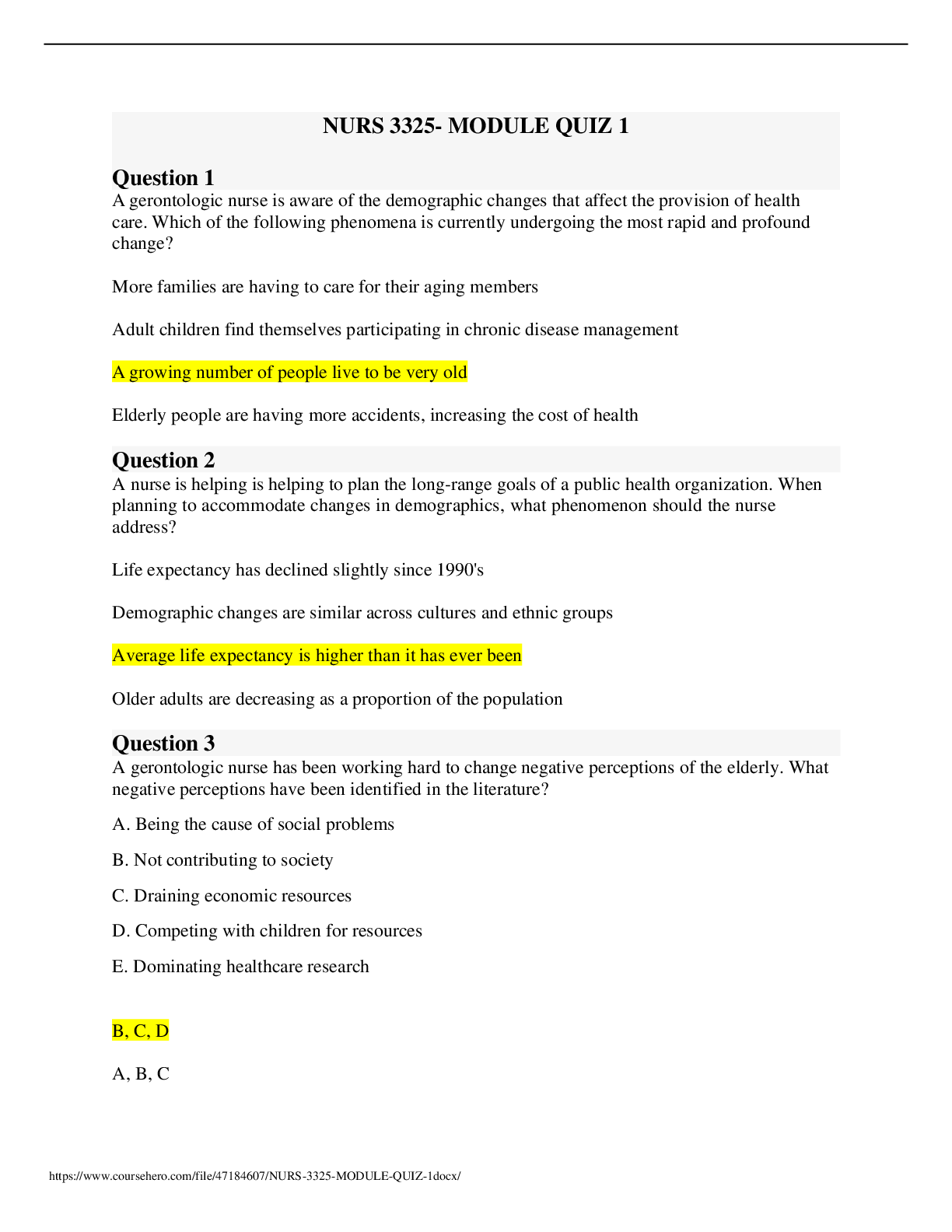
Buy this document to get the full access instantly
Instant Download Access after purchase
Add to cartInstant download
Reviews( 0 )
Document information
Connected school, study & course
About the document
Uploaded On
Mar 22, 2021
Number of pages
7
Written in
Additional information
This document has been written for:
Uploaded
Mar 22, 2021
Downloads
0
Views
38





.png)


